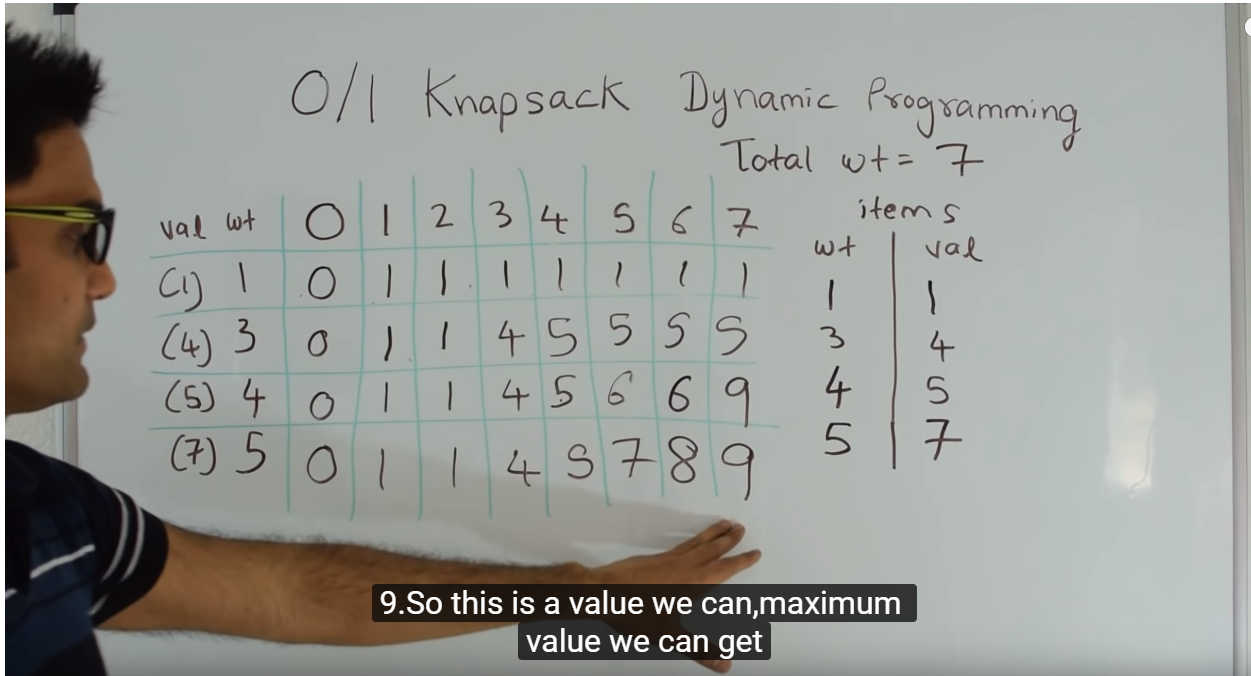0-1背包问题-DP
中文理解:
0-1背包问题:有一个贼在偷窃一家商店时,发现有n件物品,第i件物品价值vi元,重wi磅,此处vi与wi都是整数。他希望带走的东西越值钱越好,但他的背包中至多只能装下W磅的东西,W为一整数。应该带走哪几样东西?这个问题之所以称为0-1背包,是因为每件物品或被带走;或被留下;小偷不能只带走某个物品的一部分或带走同一物品两次。
在分数(部分)背包问题(fractional knapsack problem)中,场景与上面问题一样,但是窃贼可以带走物品的一部分,而不必做出0-1的二分选择。可以把0-1背包问题的一件物品想象成一个金锭,而部分问题中的一件物品则更像金沙。
两种背包问题都具有最优子结构性质。对0-1背包问题,考虑重量不超过W而价值最高的装包方案。如果我们将商品j从此方案中删除,则剩余商品必须是重量不超过W-wj的价值最高的方案(小偷只能从不包括商品j的n-1个商品中选择拿走哪些)。
虽然两个问题相似,但我们用贪心策略可以求解背包问题,而不能求解0-1背包问题,为了求解部分数背包问题,我们首先计算每个商品的每磅价值vi/wi。遵循贪心策略,小偷首先尽量多地拿走每磅价值最高的商品,如果该商品已全部拿走而背包未装满,他继续尽量多地拿走每磅价值第二高的商品,依次类推,直到达到重量上限W。因此,通过将商品按每磅价值排序,贪心算法的时间运行时间是O(nlgn)。
为了说明贪心这一贪心策略对0-1背包问题无效,考虑下图所示的问题实例。此例包含3个商品和一个能容纳50磅重量的背包。商品1重10磅,价值60美元。商品2重20磅,价值100美元。商品3重30磅,价值120美元。因此,商品1的每磅价值为6美元,高于商品2的每磅价值5美元和商品3的每磅价值4美元。因此,上述贪心策略会首先拿走商品1。但是,最优解应该是商品2和商品3,而留下商品1。拿走商品1的两种方案都是次优的。
但是,对于分数背包问题,上述贪心策略首先拿走商品1,是可以生成最优解的。拿走商品1的策略对0-1背包问题无效是因为小偷无法装满背包,空闲空间降低了方案的有效每磅价值。在0-1背包问题中,当我们考虑是否将一个商品装入背包时,必须比较包含此商品的子问题的解与不包含它的子问题的解,然后才能做出选择。这会导致大量的重叠子问题——动态规划的标识。

Knapsack Problem
The knapsack problem or rucksack problem is a problem in combinatorial optimization: Given a set of items, each with a weight and a value, determine the number of each item to include in a collection so that the total weight is less than or equal to a given limit and the total value is as large as possible.
It derives its name from the problem faced by someone who is constrained by a fixed-size knapsack and must fill it with the most valuable items.
Example of a one-dimensional (constraint) knapsack problem: which boxes should be chosen to maximize the amount of money while still keeping the overall weight under or equal to 15 kg?
思路:
1.构建二维矩阵

2.找到最合适的项

3.程序表示

代码如下:
// Solve 0/1 knapsack problem // Dynamic Programming approach. solveZeroOneKnapsackProblem() { // We do two sorts because in case of equal weights but different values // we need to take the most valuable items first. this.sortPossibleItemsByValue(); this.sortPossibleItemsByWeight(); this.selectedItems = []; // Create knapsack values matrix. const numberOfRows = this.possibleItems.length; const numberOfColumns = this.weightLimit; const knapsackMatrix = Array(numberOfRows).fill(null).map(() => { return Array(numberOfColumns + 1).fill(null); }); // 初始化矩阵第一列 for (let itemIndex = 0; itemIndex < this.possibleItems.length; itemIndex += 1) { knapsackMatrix[itemIndex][0] = 0; } //初始化矩阵第一行 for (let weightIndex = 1; weightIndex <= this.weightLimit; weightIndex += 1) { const itemIndex = 0; const itemWeight = this.possibleItems[itemIndex].weight; const itemValue = this.possibleItems[itemIndex].value; knapsackMatrix[itemIndex][weightIndex] = itemWeight <= weightIndex ? itemValue : 0; } // Go through combinations of how we may add items to knapsack and // define what weight/value we would receive using Dynamic Programming // approach. for (let itemIndex = 1; itemIndex < this.possibleItems.length; itemIndex += 1) { for (let weightIndex = 1; weightIndex <= this.weightLimit; weightIndex += 1) { const currentItemWeight = this.possibleItems[itemIndex].weight; const currentItemValue = this.possibleItems[itemIndex].value; if (currentItemWeight > weightIndex) { knapsackMatrix[itemIndex][weightIndex] = knapsackMatrix[itemIndex - 1][weightIndex]; } else { // 考虑是否选择当前物品的重量与价值 knapsackMatrix[itemIndex][weightIndex] = Math.max( currentItemValue + knapsackMatrix[itemIndex - 1][weightIndex - currentItemWeight], knapsackMatrix[itemIndex - 1][weightIndex], ); } } } //对二维矩阵进行回溯,以确定相应的项------回溯这里的代码看不大懂 let itemIndex = this.possibleItems.length - 1; let weightIndex = this.weightLimit; while (itemIndex > 0) { const currentItem = this.possibleItems[itemIndex]; const prevItem = this.possibleItems[itemIndex - 1]; // Check if matrix value came from top (from previous item). // In this case this would mean that we need to include previous item // to the list of selected items. if ( knapsackMatrix[itemIndex][weightIndex] && knapsackMatrix[itemIndex][weightIndex] === knapsackMatrix[itemIndex - 1][weightIndex] ) { // Check if there are several items with the same weight but with the different values. // We need to add highest item in the matrix that is possible to get the highest value. const prevSumValue = knapsackMatrix[itemIndex - 1][weightIndex]; const prevPrevSumValue = knapsackMatrix[itemIndex - 2][weightIndex]; if ( !prevSumValue || (prevSumValue && prevPrevSumValue !== prevSumValue) ) { this.selectedItems.push(prevItem); } } else if (knapsackMatrix[itemIndex - 1][weightIndex - currentItem.weight]) { this.selectedItems.push(prevItem); weightIndex -= currentItem.weight; } itemIndex -= 1; } }


